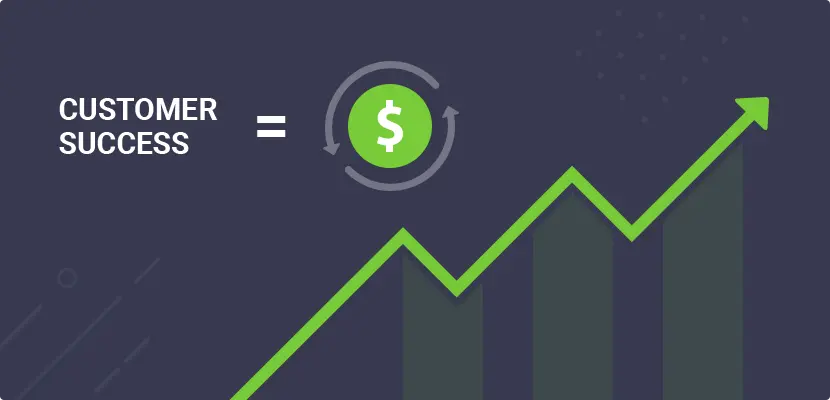Imagine a perfect sync between your customer success and sales departments.
For some, it’s a good dream. For others, it’s already a reality. Of course, you’re here, which means your sales to CS handoff needs a bit of work.
The first step in our article is seeing what the ideal process looks like, after which we’ll go through questions to ask yourself for the handoff to work. Towards the end, you’ll see how to apply the advice to your team.
Read on for insights from real salespeople, customer success experts, and business leaders.
Ideal Sales to Customer Success Handoff
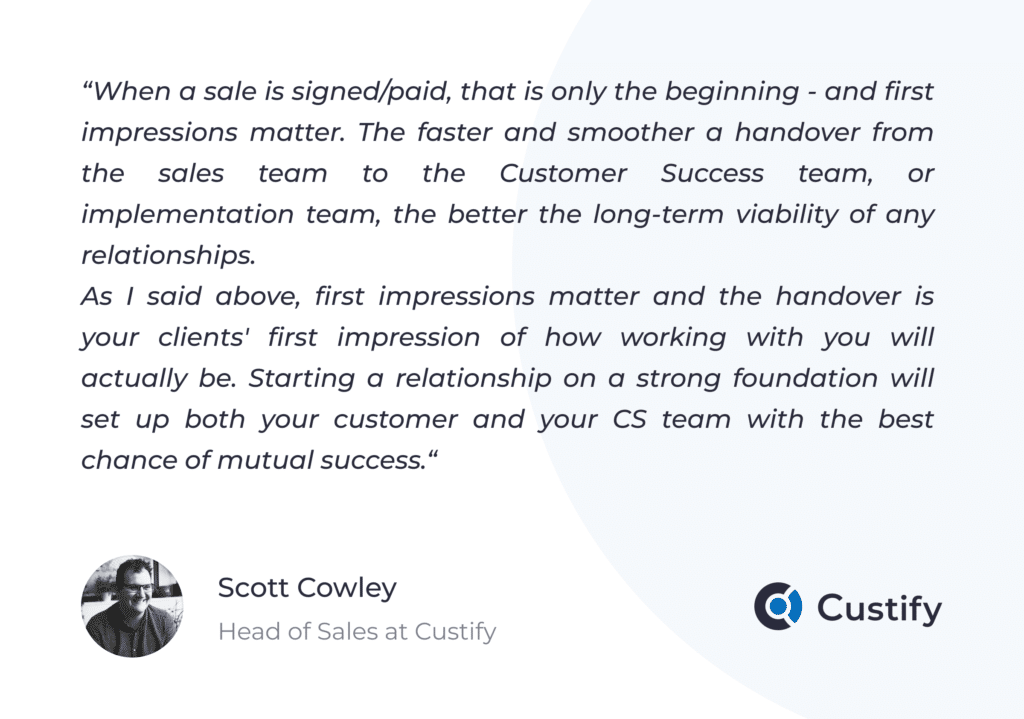
Optimizing your handoff process means perfecting the first impression your client gets. As you’ll see in this article, there are many varied approaches to pick from. Some prefer introductions over email, others advocate for late-stage customer success handoffs, such as adding the CS rep one week before the monthly sales close.
Of course, the perfect process here is also very dependent on your type of SaaS and how much support your clients need to achieve success with your product.
But there are some general best practices that all CS – sales handoffs should take into account:
- Ensure proper Sales-CS alignment. Before sales happen, CS must lead the effort to establish One Customer Journey, a single set of business goals, and a company-wide customer-centric approach that also is embedded in those business goals. Furthermore, CS must ensure both Sales and Marketing know, understand, and correctly sell the company’s products and services. All these small but vital adjustments can make a huge difference down the line and frequently lead to increased CLV, ARPU, and customer loyalty.
- Introduce the CS team. Even if you’re formally passing the torch at a later stage, introducing the CS rep as early as possible means the customer knows that rep when they eventually work together. It also reinforces their belief that you’re working with their success as a goal.
- Always keep in touch. CS and sales need to have regular syncs, no fewer than one every two weeks, but preferably weekly.
- Keep CS in the loop. Regardless of the precise moment when you make formal introductions, customer success reps must get some written notes or updates too. They need to know what’s happening with the accounts they might receive, so keep them CCed or offer weekly status reports.
- Offer total transparency. Fresh clients or prospects you’re about to close with already have a high churn risk because they haven’t reached that “a-ha moment”. Updating them on their steps to success, mentioning everything that’s happening, and explaining the process helps ease any anxieties, assures them you’re working for them, thus improving retention and loyalty.
Here’s what Marc Bromhall, Founder of StorageBuddy, has to say on this:
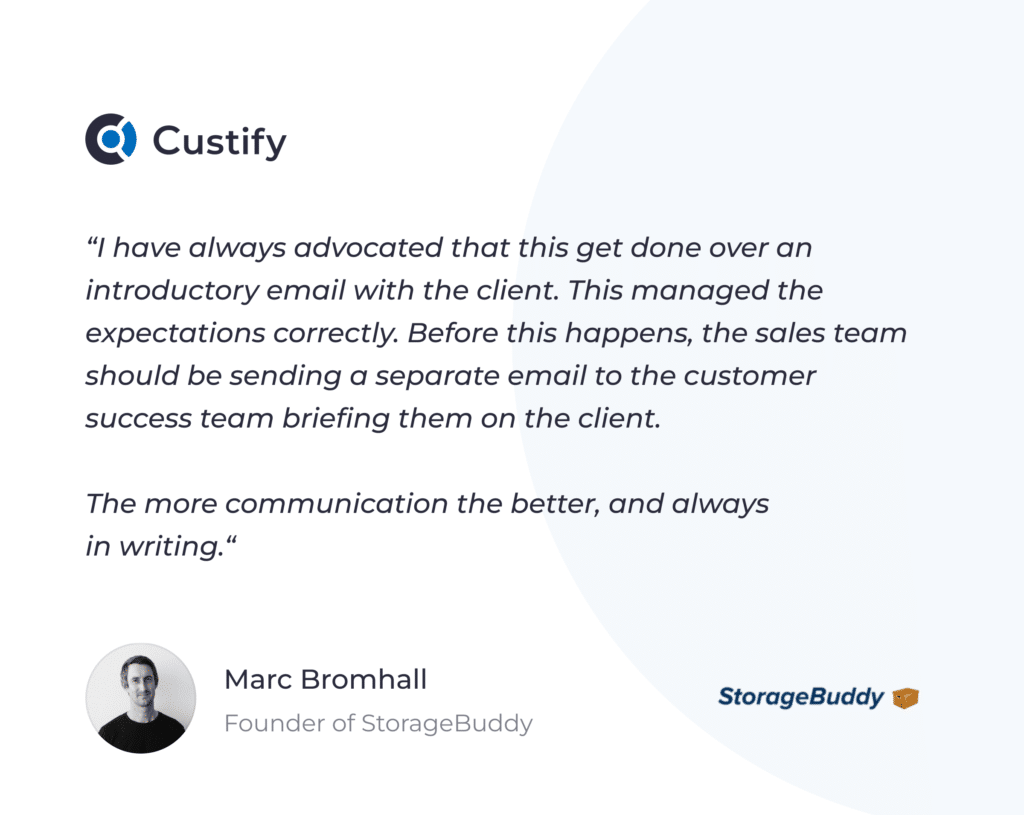
Platforms and Processes to Get the Job Done
To make your sales to customer success handoff ideals real, you need good people, processes, and platforms. While the people part’s on you, we can help with the others:
1. A platform shared between CS and Sales teams
Any organization looking for the perfect CS – Sales sync needs a shared platform. This could be your CRM, a customer success platform like Custify, any other internal sync app you have, or just a spreadsheet if you’re really strapped for cash. The only requirement here is that it’s shared between the two teams.
2. Automation solutions to facilitate scaling
Sure, you might nail the sync for your first few customers. But the more accounts you get, the bigger their business, the smaller the likelihood that your handoff will go over smoothly. Your customer success, support, or relationship management tools can most likely help here.
Jeff Heckler, Director of Customer Success at MarketSource, has an interesting insight on this topic:
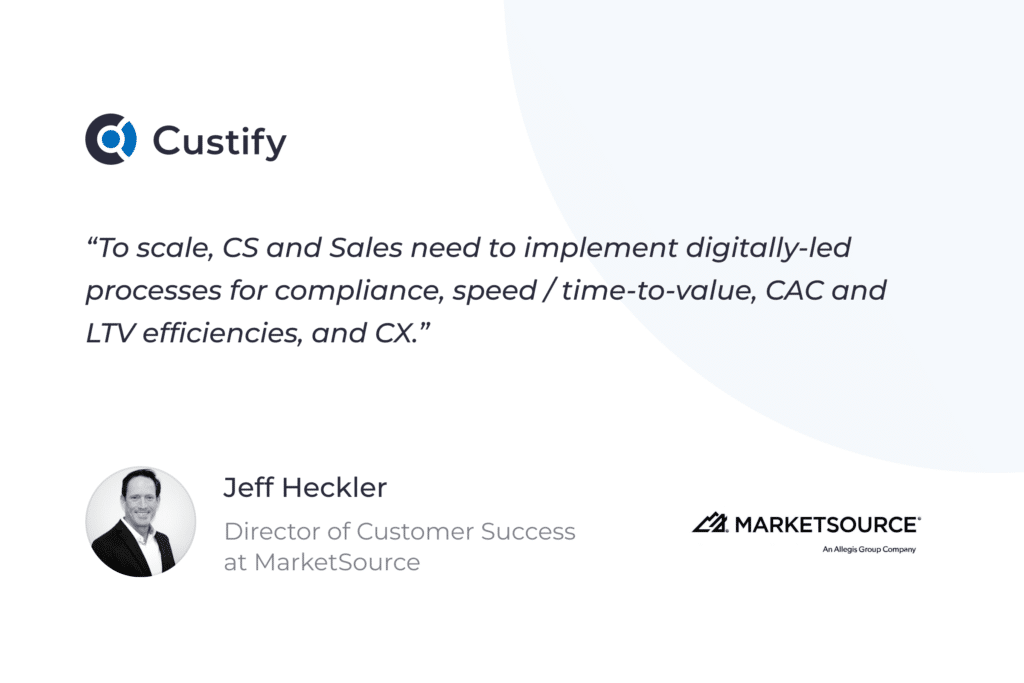
3. A responsibility assignment matrix you can depend on
Divvying up the roles between the two teams can be difficult, particularly since Sales is the more well-established role, traditionally handling many current CS responsibilities.
Your RACI model needs to correctly outline the responsibilities and roles of both CS and sales, to ensure great Customer Experience, great Employee Experience, and generate results for both parties.
A quick note on the above graphic – in this case, high touch refers to very large companies with multiple departments. In such organizations, it’s very common to have account managers, project managers, implementation consultants, and education specialists working side by side with CSMs and sales.
Sales to Customer Success Handoff – Questions to Ask Yourself
As I already mentioned, there are several questions to settle before the handoff process can be done. Like with previous points, there’s also no one way to answer them. There are best practices, true, but most of what you answer depends on your business.
However, the point of answering these at the end of the day is to have a clear picture of what you want, what you have, and what you can achieve.
1. When do sales reps introduce the CSM?
There are several ways to do this. Pick one and stick by it!
- Introductions can be made over email and true face-to-face or video meetings can happen together with the handoff itself. This approach works well and is likely the safest option. It still keeps CS informed, but with a somewhat reduced role during the initial acquisition stages.
- Introducing the CS rep during the first few meetings. This is great if you want a tight relationship between internal departments and between those departments and the customers.
- Introducing CS sometime before the deal is closed. It could be a week before, a few days, or up to a month or more for large contracts with many stakeholders. It’s really up to you, but this is probably the most customer-friendly option you have. You can optionally introduce them over email prior to this meeting too, improving CX even more.
Whichever option you pick, remember what David Reid, Sales Director at VEM, mentioned:
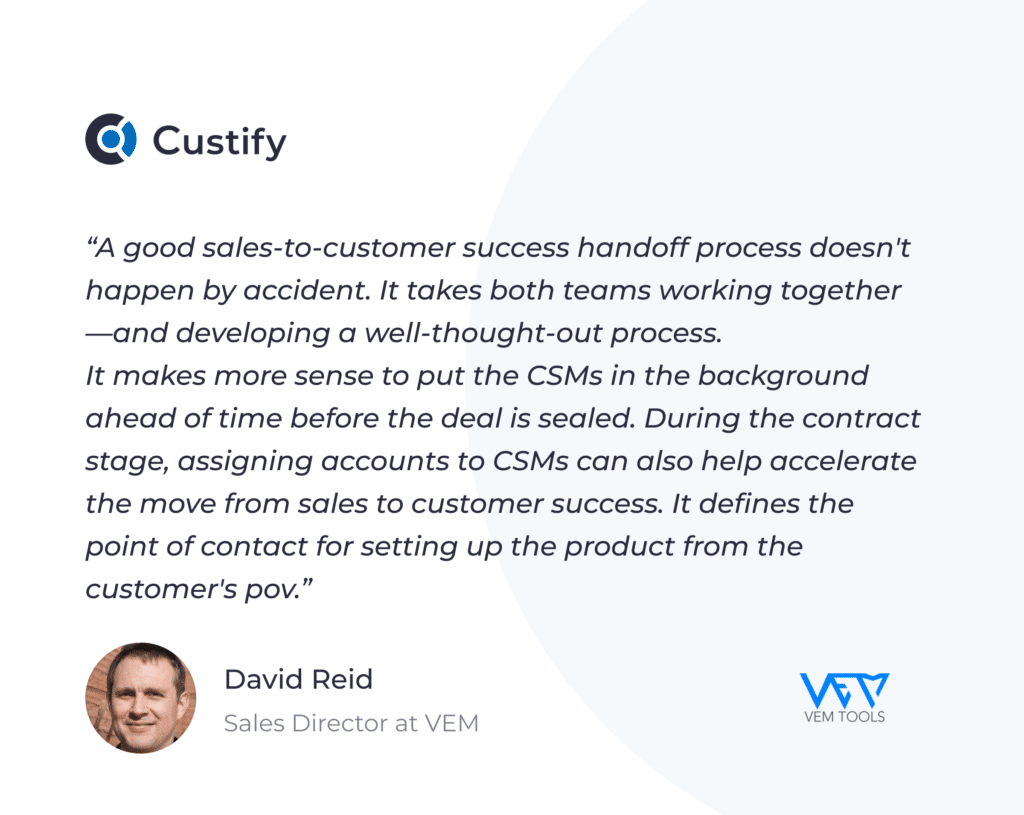
2. Is it a smooth transition or a simple switch?
While we don’t typically recommend simply switching from sales to customer success, oftentimes, it’s very confusing for your customers, leading to poor CX and early churn reasons.
However, for some SaaS, overcomplicating this process can also have negative effects. If your product is simple, easy to use, and doesn’t require a lot of support, there’s no reason to make a big deal of the sales to CS handoff.
Plan as best you can, survey your customers to see what they think, and always adjust based on feedback.
3. When does the handoff happen?
Similarly, the precise moment for sales to CS handoff also varies based on your type of SaaS. As a general rule, you need customer success to be there as soon as the potential customer has decided to go with you.
CSMs need to take advantage of the time before sales close to learn all they can about the new customer in order to better help them once they’re on board.
We asked Theola Tinny, Co-Founder at VinPit, for her thoughts on this:

4. What is the role of Sales in the handoff?
You can define the role of sales during the handoff by using the RACI matrix above, yet it’s always helpful to review a checklist of things Sales needs to do:
- Have an overview of the implementation
- Conduct scoping calls
- Introduce the success team
- Introduce the account manager
- Ensure proper knowledge transfer
- Review project plan
- Take part in the internal sales transition call
- Take part in the welcome call
5. What is the role of CS in the handoff?
You can also have the role of CS during the handoff in the RACI matrix. Let’s go through the CSM’s checklist as well:
- Stay informed about the account
- Research how to best help the new account
- Lead the internal sales transition call
- Create a customer success plan for the new client
- Take part in the welcome call
- Introduce the support team
- Oversee onboarding and conduct training
6. What tools can we use to make the handoff more efficient?
The account handoff from sales to customer success depends on visibility, communication, efficient project management, and, most importantly, data hygiene. All data must be adequately collected, stored, secured, and passed on to the customer success team members that need to see it.
For this and other parts of the account move from sales to CS, you need a few tools:
- A good CRM
- A tool that has automation
- A great customer success
- A great tool for client communications
- A good task management platform
Many of these will be in present in a single platform or two. However, a fully integrated tech stack is the most important thing to ensure proper knowledge transfer and relevant account dashboards for Sales & CS.
A complete lack of sync between both teams happens too often. Having different health scores and metrics in different places, with different targets for KPIs, is a nightmare worth avoiding by simply making sure all your tools complement each other.
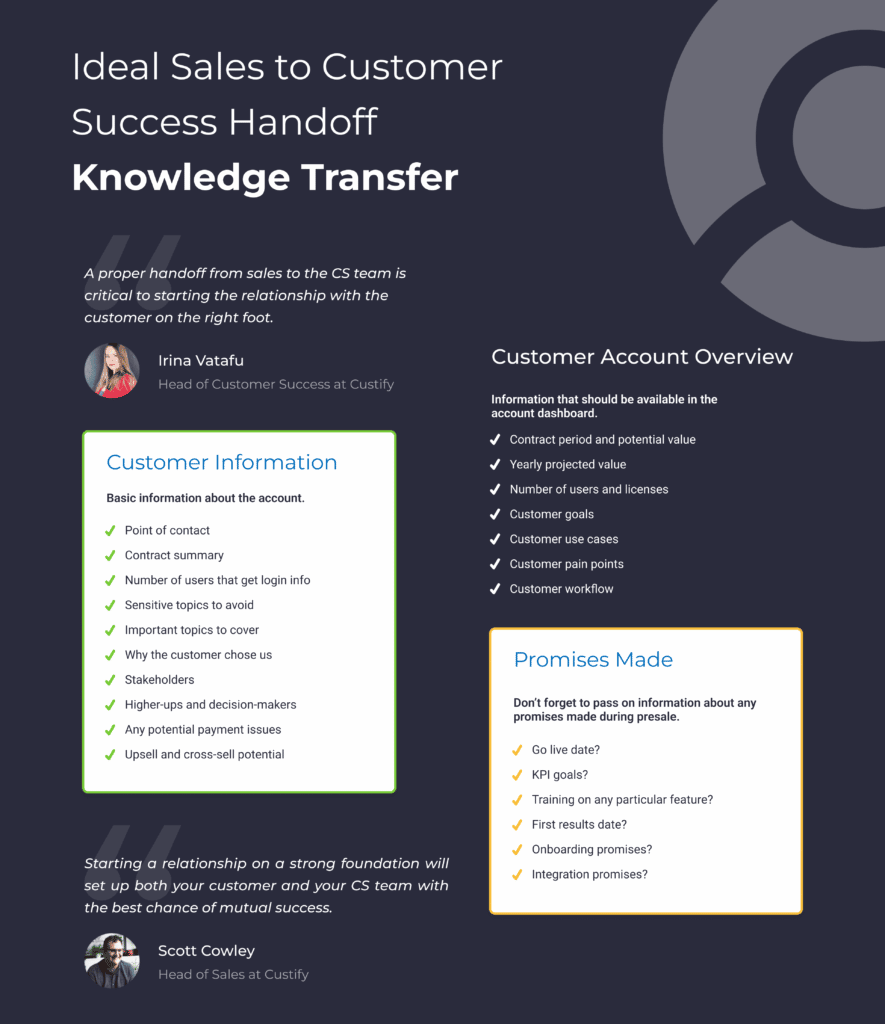
The 4 Principles to Develop a Handoff Process that Works for You
1. Communication
“Setting the right expectations in the sales process facilitates a smooth transition. When sales teams explain the next steps and customer success fully respects them, it shows the customer that they can trust you, that they can rely on you, and that they won’t have any unwanted surprises in their relationship with you. An abrupt change and false expectations can damage the relationship and lead to a quick churn, which we want to avoid through a proper handover between sales and customer success and aligned processes.”
Irina Vatafu, Head of Customer Success at Custify
Communication doesn’t just mean talking to the customer, or talking to the salesperson or customer success person. It’s bout ensuring that all parties involved, but particularly internal ones, explain what’s happening at all times and transfer the necessary information to the others.
This effectively means Sales must make sure to pass information to CS. CS must make sure to get the correct information, and communicate with the customer. Then, both teams should help the customer offer valid and necessary data for their mutual success.
Communicating with the customer also means informing them of your progress towards their goals, about how you’re helping them achieve success.
Here’s what Lyle Florez, Founder at EasyPeopleSearch, has to say on this:

2. Alignment
Sales and customer success have completely distinct goals and naturally focus on different things while interacting with new customers. If your job depends on achieving a sales-generated revenue quota, you won’t be able to keep an eye on customer churn rates.
As such, aligning tools, communication channels, metrics, KPIs, and your tech stack (as stated previously) can help both teams understand the focus of the account handoff process.
Deeper alignment on client goals, product capabilities, and on the customer journey is also vital to long and fruitful customer relationships. And marketing must be brought into these discussions to ensure they’re using messaging that reflects what’s in the product.
Think of it like this: a customer that’s been sold lies will be quick to churn once they don’t receive the value they expected – so both Sales and Marketing must do their best to understand the product before they proceed to sell it.
3. Research
Customer research isn’t only the province of Customer Success. The sales team needs to secure the initial account information necessary for all departments, especially customer success. Sometimes, this means more than simply asking the customer – it’s a careful combination of research skills, communication skills, and note-taking skills.
Here are some account details you should never forget:
- contract period and potential value
- yearly projected value
- number of users and licenses
- customer goals
- customer use cases
- customer pain points
- stakeholders
- Point of contact
- higher-ups and decision-makers
4. Strategy
Strategy comes in for both your internal processes as well as CS.
For the ownership switch to go over smoothly, you need to write down your strategy, put a process together based on your experience and what you’ve learned here, and stick by it.
Then the customer success team will implement their own strategy for ensuring success, which often involves Sales to varying degrees.
The constant cross-departmental collab creates the perfect opportunities to align the goals of Sales and CS and create a positive relationship with the customer.
The Best Process Lies in a Good Partnership
The ideal sales to customer success handoff isn’t just about tasks and processes, tools, and RACI matrices. It’s the one that prioritizes the partnership aspect of the handoff, while correctly bringing business and customer context into the mix.
And of course, as already stated, it’s all about what your business and your customers need. There’s no template for ideal customer success, but you can build a version of it that works for you.



